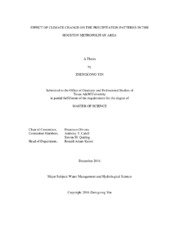| dc.description.abstract | Because extreme precipitation poses a potential threat to local water resource systems, this study predicts and analyzes future precipitation in the Houston area. The Modified Bartlett-Lewis Rectangular Pulse (MBLRP) model was utilized to generate stochastic precipitation based on source data. Observed precipitation of seven rainfall stations around the Houston area and daily precipitation data extracted from Global Circulation Model (GCM) were used as source data.
With respect to the statistics of precipitation, the MBLRP model reproduced the mean, variance and probability of zero rainfall well, but lag-1 autocorrelation coefficient was not reproduced well. With low frequency events, the MBLRP model tended to overestimate extreme precipitation. As for the duration curve, the MBLRP model performed well for reproducing precipitation events at probabilities larger than 1%, but it had a limited ability to reproduce the low frequency events. Compared to the MBLRP model, the GCM exhibited more uncertainty because of a tendency to systematically underestimate the amount of precipitation and annual hourly extreme value for different accumulation levels. The usage of the statistics relationship equations of observed precipitation for different accumulation levels introduced more uncertainty into the whole process, namely overestimation of precipitation. Among the three sources of uncertainty: the MBLRP method, the GCM, and the statistics relationship equations, the GCM, which represents the source of data, introduced more uncertainty into the prediction results.
Climate change has some impact on precipitation in the future in terms of changes in rainfall frequency and mean amount of rainfall. The duration curves indicate that the amount of future daily precipitation is larger than the present under the same probabilities. The annual hourly extreme precipitation largely depends on the local precipitation pattern and the selected model rather than the effect of climate change. Both the duration curve analysis and the frequency analysis show that the effect of climate change on precipitation is relatively small in the Houston area.
This study provides a framework for estimating the effect of climate change on precipitation, which can be applied to any area with historic data available. | en |


